| Name |
General Description |
Photo |
|
STREET TREES |
|
| Superform Norway Maple - Acer platanoides 'Superform' |
This cultivar of Norway Maple has a height and spread of 40 to 50 feet. The rounded crown is very uniform. Norway Maple's dense shade and shallow root system competes with lawn grasses, and the shallow roots can make mowing under the tree difficult. The tree grows quickly, is adapted to a wide variety of soils and has brilliant yellow fall color unmatched by most trees. It is well adapted to street tree plantings and has a straight trunk. Hardiness zone 5 |
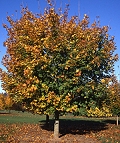 |
| Hackberry - Celtis occidentalis’ |
The tree forms a rounded vase reaching a height of 40 to 80 feet, is a rapid grower. The mature bark is light gray, rough and corky and the small fruit turns from orange red to purple and is relished by birds. Hackberry may take a while to establish itself due to the extensive, coarsely branched root system, It is wind, drought, salt and pollution tolerant once established and is considered a moderately tough, urban-tolerant tree. Other trees are more attractive. An example can be seen in front of unit 59. Hardiness zone 2b |
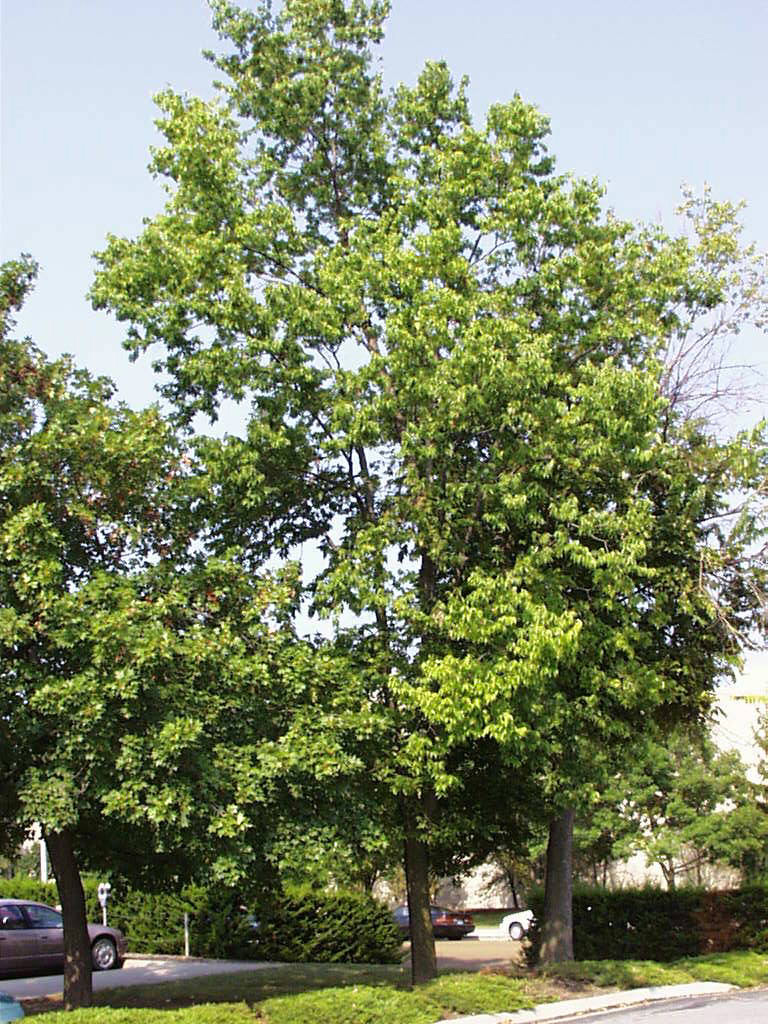 |
| Sunburst Honeylocust - Gledistia tricanthos 'Sunburst' |
Sunburst Honeylocust is a deciduous tree, growing 30 to 70 feet in height, with an open, spreading crown and distinctive horizontal branches. It prefers full sun, is very hardy and is fruitless. The fine textured foliage of this tree provides dappled shade. Compound leaves are yellow upon emerging, turning light green in summer. Fall color is consistently yellow. Shademaster Honeylocust, with green foliage, is planted throughout the complex. Both varieties are susceptible to leaf hopper and are a bit messy when there is a strong wind.
|
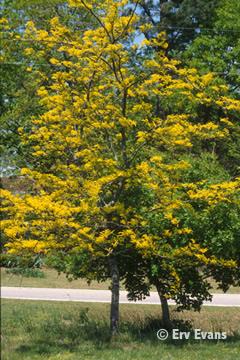 |
| London Plane tree - Plantinus x acerfolia |
London Plane tree is a hybrid sycamore resulting from crosses of American sycamore and oriental sycamore. London Plane tree is an important landscape tree because of its resistance to diseases and ability to grow rapidly in urban soils. London Plane tree prefers deep, rich, moist soils that are well drained. However, this species is able to withstand most soil conditions, including high pH and compaction. The most striking feature of the London Plane tree is its flaking bark that peels to reveal a lighter colored bark underneath. Best used only in open areas where its growth will not be restricted. growing to 60 - 100 feet tall. Branches are a bit weak and can break in wind and ice storms. Examples can be found south of unit 52.
|
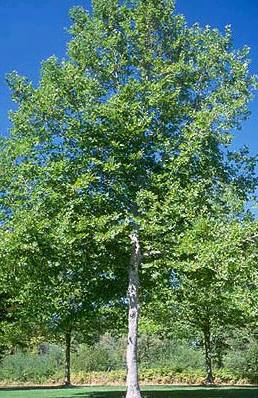 |
| Red Oak - Quercus rubra |
An adaptable, widely planted oak with a rapid growth rate, Red Oak will reach a height of 60 to 70 feet and a spread of 40 to 60 feet. Branches and upper trunk are marked with long, light grey longitudinal lines which remind some people of ski trails. Its form is rounded which makes a nice shade, park or street tree. Acorns are small and easily cleaned up, broken into small pieces by pedestrians or eaten by squirrels. The foliage turns a wonderful dark red in the fall.
|
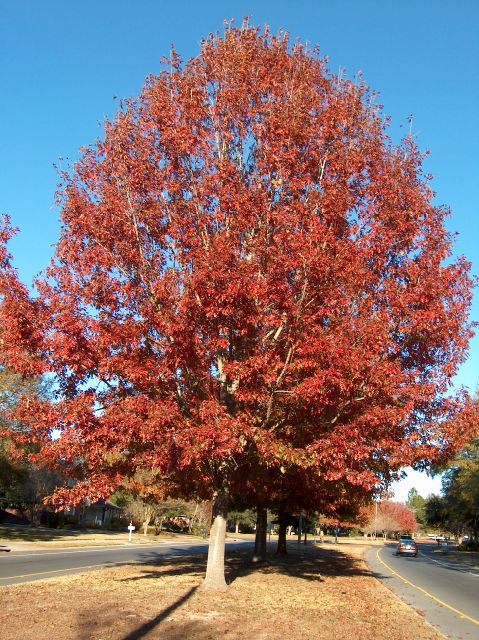 |
| Glenleven Linden - Tilia cordata 'Glenleven' |
Glenleven' Littleleaf Linden grows in a cone shape about 50 to 70 feet tall and can spread 40 to 50 feet in most landscapes. This tree has a faster growth rate than other littleleaf Lindens with a more open, canopy forming a moderately dense pyramidal to oval crown which casts moderate shade. Littleleaf Linden is a prolific bloomer, the small fragrant flowers appearing in late June and into July. Japanese beetles often skeletonize Linden foliage. Hardiness zone 3 |
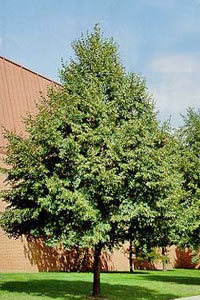 |
|
OTHER TREES |
|
| Nootka Weeping Cypress - Chamaecyparis nootkatensis 'Pendula' |
Nootka Weeping Cypress resembles Cypress, with flattened sprays of aromatic foliage on feathery branches which create a pyramidal shape. Most grow to 50 feet tall. The ridged, reddish-brown bark peels off. Free from pests and disease. Hardiness zone 5a |
 |
| Black Walnut - Juglans nigra |
Black Walnut grows with a rounded crown to about 70 feet and spreads 60 to 80 feet. Best growth occurs in a sunny open location and a moist rich soil, common along stream banks in its native habitat. The tree grows rapidly when young but slows down with age. While valued as a lumber tree it poisons the soil under its canopy, severely limiting what can be grown there. The nuts are edible but are a nuisance to clean up and leaves often fall prematurely. Black Walnut at Hazel Lanes predates the construction of the complex. Hardiness zone 3b |
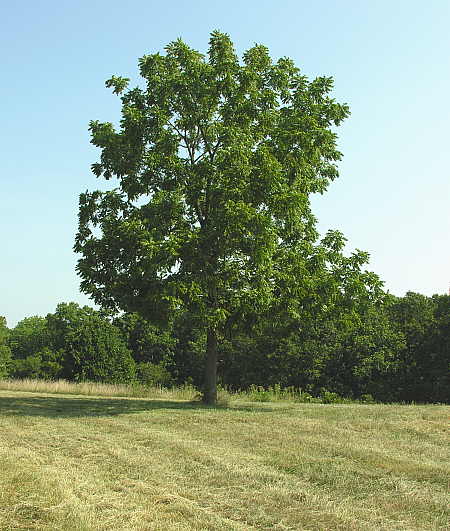 |
| Saucer Magnolia - Magnolia x soulangeana |
Saucer Magnolia is a beautiful small tree used primarily as a specimen plant. It has large waxy pink-white flowers in cloud-like profusion before leaves appear in early spring. Mature trees are 25 feet tall and 20 to 30 feet wide. |
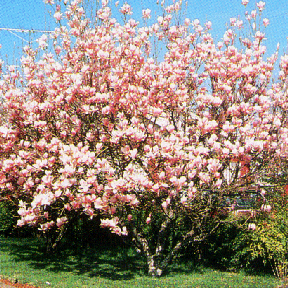 |
| Profusion Flowering Crabapple - Malus x moerlandsii 'Profusion' |
Profusion flowering crabapple is a spreading, violet-red-flowered crabapple that typically matures to 15-30 feet tall. It is noted for its rounded shape, violet-red flowers, red fruit and good disease resistance. Flowers are followed by bright red crabapples (to 1/2 inch diameter) that mature in fall and may persist into winter. Hardiness zone 4a |
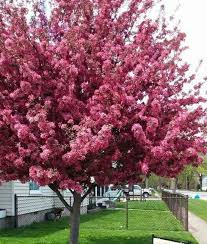 |
| Weeping Mulberry - Morus alba "Pendula' |
Weeping Mulberry used at Hazel Lanes is fruitless, a definite plus when compared to the mess created by the abundant fruits of the common White Mulberry. The plant quickly forms a dark green mass of foliage from a short trunk. This gives many people reason to plant the tree as it remains relatively compact and its branches are interesting in winter.. It has invasive surface roots. An example can be found in front of unit 2.
|
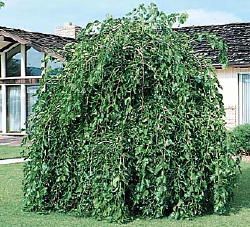 |
| Norway Spruce - Picea abies |
Norway Spruce can grow 80 to 100 feet tall and spread 25 to 40 feet. Small-diameter branches sweep horizontally from the straight trunk which can grow to four feet thick. Branchlets droop from the branches toward the ground in a graceful, weeping fashion forming a delicate pyramid. Many small-diameter roots originate from the base of the trunk and they are often found fairly close to the surface of the soil. The root system is shallow and often dense, particularly close to the trunk which makes growing grass difficult. |
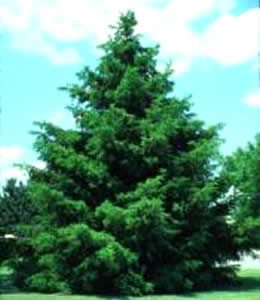 |
| Serbian Spruce - Picea omorika |
Serbian Spruce has a narrow, pyramidal silhouette with thin, graceful arching branches. The trunk grows straight and the tree requires no pruning to keep the narrow, pyramidal form. The upper surface of the needles is glossy, dark green. The lower surface is marked with two white stomata lines. The plant will grow about 50 feet tall and spread 20 feet and is one of the most elegant Spruces |
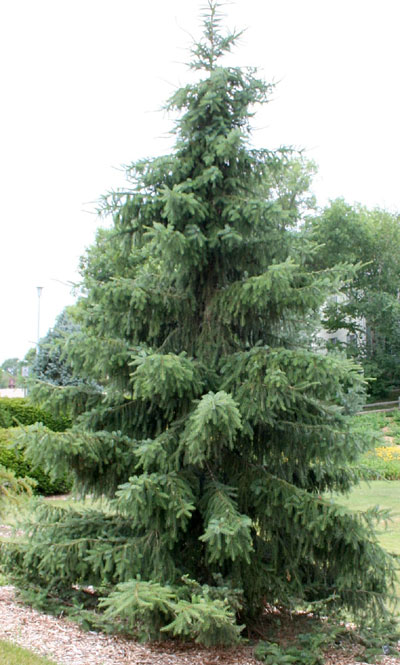 |
| Colorado Spruce - Picea pungens glauca |
Colorado Spruce has a horizontal branching habit and grows taller than 75 feet in its native habitat, but is normally seen at 30 to 50 feet in landscapes. The tree grows about twelve inches per year once established but may grow slower for several years following transplanting. Needles emerge as a soft clump, changing to a stiff, pointed needle sharp to the touch. The crown form varies from columnar to pyramidal, ranging from 10 to 20 feet in diameter. Older trees can develop Cytospora Canker causing the needles on bottom branches to turn purple and ultimately fall off. Over time, these trees will be eliminated from the complex. |
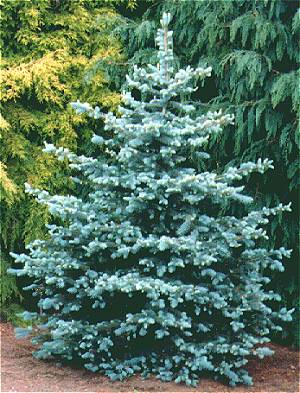 |
| White Pine - Pinus strobus |
Eastern White Pine has soft blue-green needles borne in groups of five although foliage color varies greatly from one tree to the next. It is typically 50 to 80 feet tall in landscapes. Growth is very rapid at first but slows down with age. Although young trees are pyramidal and usually grow with one central leader, the layers (or whorls) of horizontal branches give White Pine a distinctive appearance in middle and old age. Examples can be found behind the pool. |
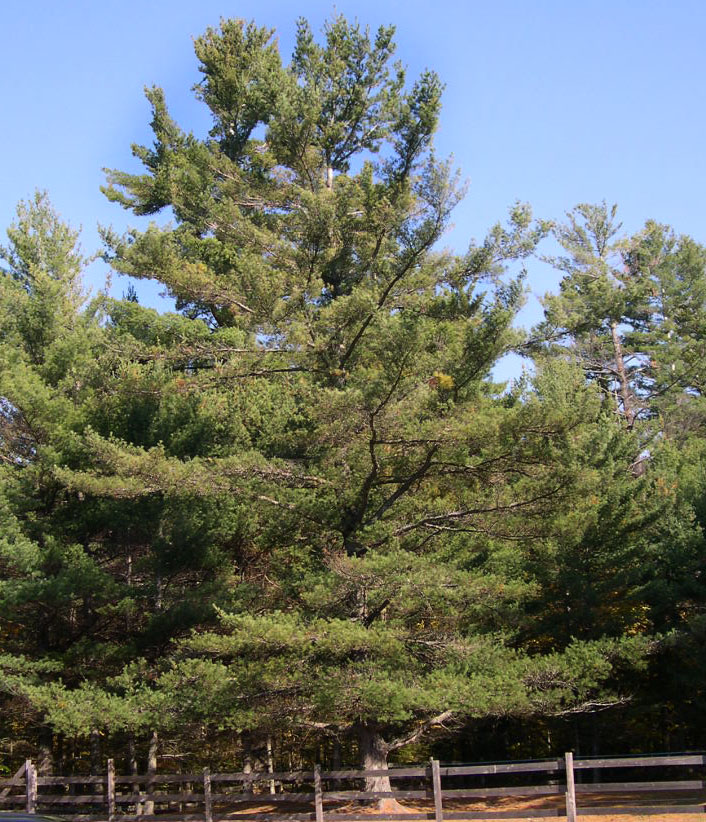 |
| Bradford Pear - Pyrus calleryana 'Bradford' |
Bradford Pear is the original introduction of Callery Pear. It has many vertical limbs with embedded bark packed closely on the trunk and grows about 40 feet high by 30 to 45 feet wide but the crown is dense and the branches long. It puts on a gorgeous, early spring display of pure white blossoms, and the small, red/brown fruits which follow will attract quite a number of birds who find them delicious. Fruit set may be increased by planting two or more cultivars of Callery Pear together. Fall color is incredible, ranging from red and orange to dark maroon. |
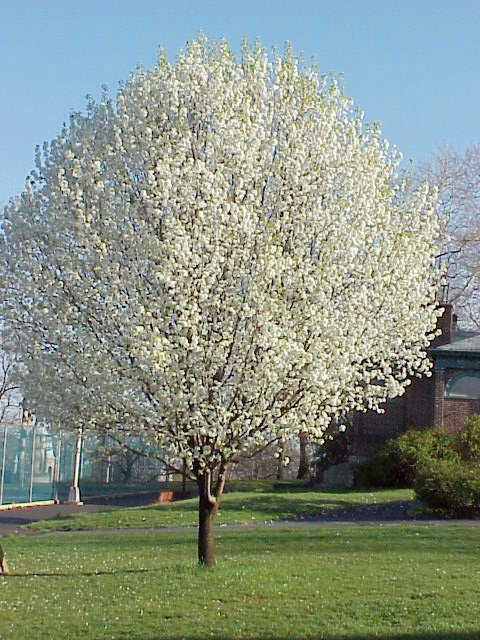 |
| Ivory Silk Tree Lilac - Syringa reticulata 'Ivory Silk' |
Ivory Silk Tree Lilac has an upright habit varies from symmetrical to irregular.`Ivory Silk' has an oval or pyramidal form when young but spreads to a rounded shape as it grows older. This is a very large shrub or small tree, reaching a height of about 20 to 30 feet with a 15-foot-spread. The huge clusters of creamy white flowers, borne in early summer for about two weeks, are the main ornamental feature but lack the fragrance of the spring-blooming lilacs. |
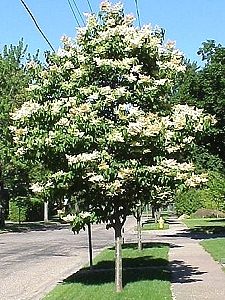 |
| White Cedar - Thuja occidentalis |
This slow-growing tree reaches 25 to 40 feet in height and spreads to about 10 to 12 feet wide, preferring a wet or moist, rich soil. Specimens at Hazel Lanes were here before the development of the complex. White Cedar likes high humidity and tolerates wet soils and some drought. The foliage turns brownish in winter, especially on exposed sites open to the wind. Has a loose habit; black cedar is a better choice.
|
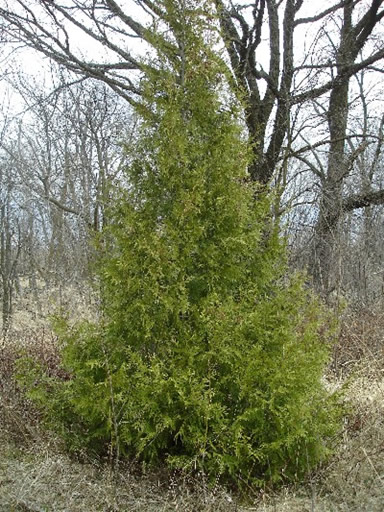 |
| Black Cedar - Thuja occidentalis 'Nigra' |
Black cedar is widely used as an accent tree or as a privacy hedge tree. It has a broad pyramidal shape with erect branches that are dense and crowded together. The leaf color is bright green above and pale green below. It may be sheared and shaped to fit into most every landscaping need. It typically reaches 50 to 70 feet in height with a spread of 15 to 20 feet. The insignificant yellow flowers are followed by small, half-inch cones which seem a little out-of-place on such a large tree. |
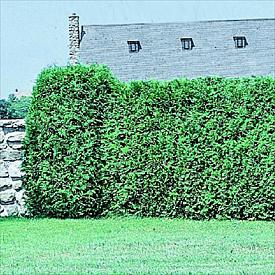 |
| Emerald Pyramidal Cedar - Thuja occidentalis 'Emerald' |
Emerald Pyramidal Cedar has beautiful emerald green foliage on a very compact pyramidal cedar. It has many of the features of Black Cedar, except that its foliage is more dense. It prefers deep, moist, well-drained soil. Growth is moderate. Emerald Pyramidal Cedar reaches 10 to 20 feet at maturity. |
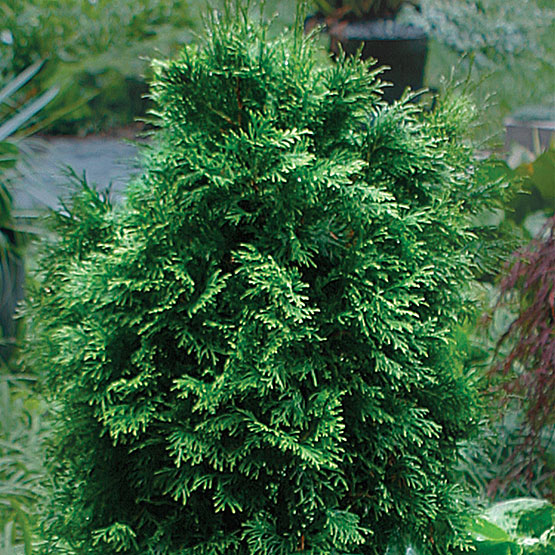 |
| Canadian Hemlock - Tsuga canadensis' |
Canadian Hemlock may be one of the most beautiful conifers, with its soft green needles attached to gently arching branches, often reaching to the ground. Specimen trees look their best with lower branches left on and touching the ground. The strong, conical form is supported by one, straight central trunk. Canadian Hemlock will grow 50 to 70 feet tall and 30 feet wide, but is tolerant of shearing. Canadian Hemlock does well in dense shaded araes. Hardiness zone 3a |
 |





















